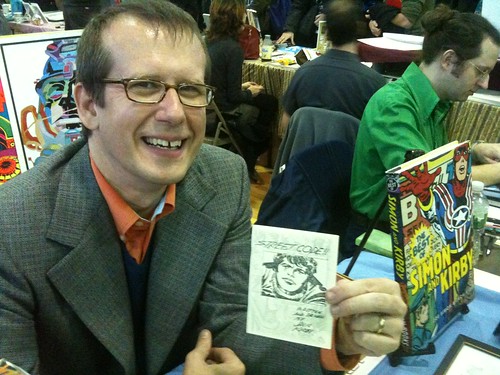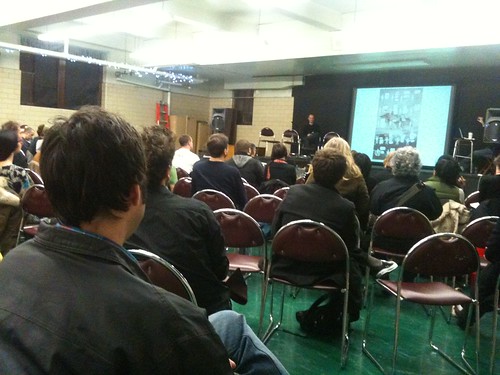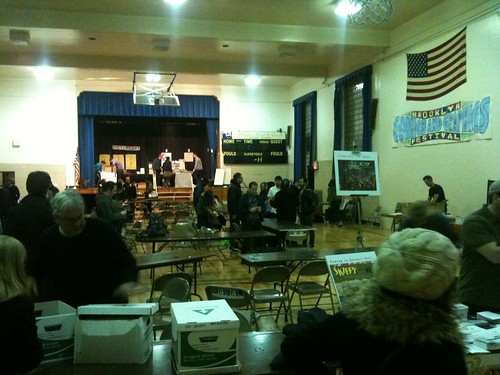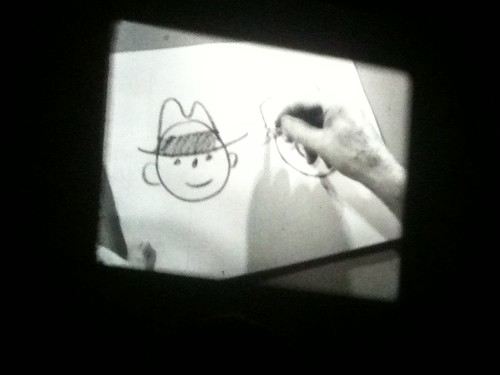The Brooklyn Comics and Graphics Fest was a week ago Saturday, so all of this is a little belated, but I just wanted to take a second to say that, as someone attending the festival for the first time, I kind of loved it and I kind of hated it. Although my initial impressions, all formed during two panels featuring Art Spiegelman, Chris Ware and Lilli Carre, among others, and moderated by festival cofounder Bill Kartalopoulos, were all very positive, my quick jaunt in the show area of the festival itself left my sweaty and breathless. I can see why the fest's organizers like the space, at Our Lady of Mt. Carmel Church, but the sheer number of people milling around made it impossible for me to enjoy myself and, more importantly, to do the discovery that I came to do. Of the eleven books I went home with, I had walked into the show intending to buy six, with an established desire to also check out Blexbolex, whose books I ended up buying at Desert Island later, rather than in the exhibit hall itself.
That I shimmied out of Our Lady of Mt. Carmel as fast as I could manage isn't any kind of tragedy, but I would have liked to have been able to investigate more stuff before I became too flustered to function, particularly since the festival did a very good job of attracting European and Canadian publishers with whom I have very little experience or exposure. I also would have liked to have spoken to Jordan Crane; although I purchased all four volumes of his Keeping Two collection minis, I would have liked to have had his ear for awhile, if only to say that I give The Last Lonely Saturday to anyone who doesn't believe that comics are worthwhile. That I didn't feel like I was able to is, I should add, my fault and my fault alone.
Obviously, I think its good that people are showing up to shows like this, and, obviously, I'm happy for the BCGF people that their show was such a rousing success. But I also want to say that I don't think that the organizers were prepared for the kind of crowd they were going to get: the day's first panel, which featured Spiegelman and Ware, was standing room only, and a few people were sitting in the Knitting Factory's bar and listening in to the discussion as it was going on. Kartalopoulos, for his part, seemed genuinely surprised that there was going to be such good turnout for Art Spiegelman and Chris Ware. I don't really know how to explain that. I want to like BCGF, I really do, but unless they move venues next year I don't think I'll be going again.
What I might go to, though, are happenings associated with festival but outside of the exhibitor hall. I thought all of the events and showings that I attended were excellent, and over the next few weeks I want to pick apart a few of things that Chris Ware and Art Spiegelman said in that first panel, as well as think about the gallery settings for the work of Lilli Carre and Blexbolex which, as always, is an exceedingly difficult venue in which to approach comics as a kind of readable art. I first wrote about Carre's art in a gallery context almost two years ago, and its going to be satisfying to approach again, particularly since the work she showed at Desert Island comics was much more appropriate for gallery walls that what I saw before. The work of Blexbolex and Oliver Schrauwen was similarly suited for viewing in this way, although, I think, for much different reasons, and I'll talk about that too.
All of this is to say that I think BCGF was extremely stimulating from an intellectual point of view, so much so that I'm going to spend some time writing about it, but that I wish that it had done a better job of allowing for the serendipity of discovery at the tables of the people who had come to share their work.

.JPG)
.JPG)





